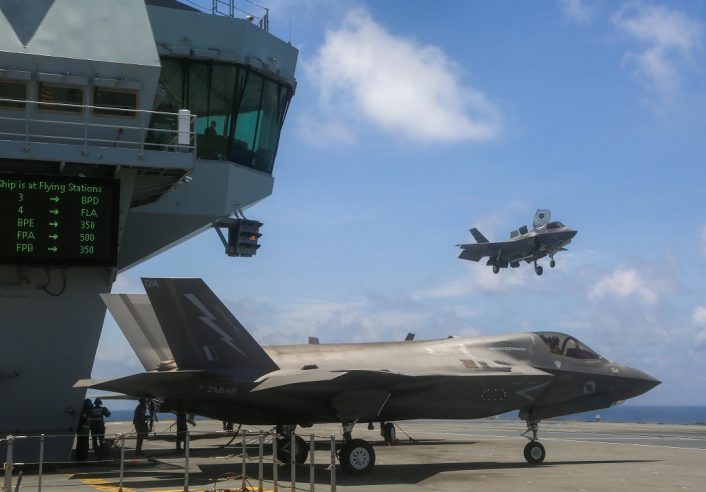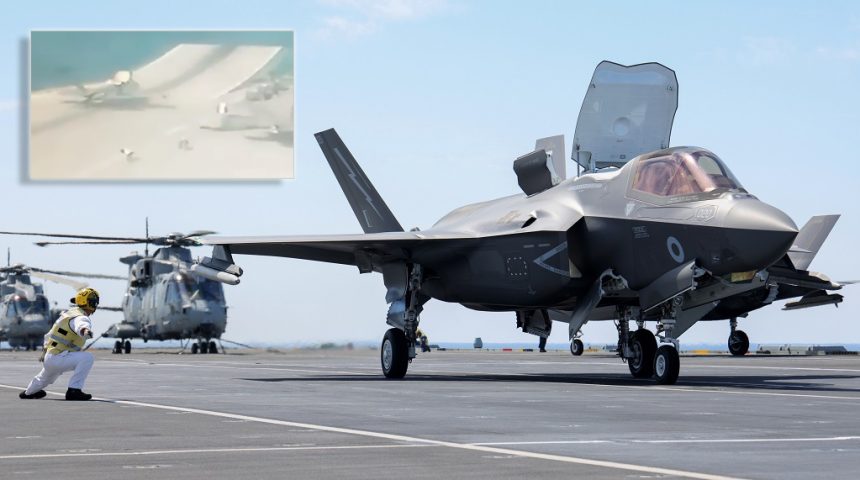The remains of the aircraft are now being transported to an allied port so it can then be airlifted back to the UK.
The United Kingdom Ministry of Defence announced on Dec. 7 the completion of the operations for the recovery of the Royal Air Force F-35B that crashed in the Mediterranean Sea. As we already extensively reported, the aircraft crashed while taking off from the HMS Queen Elizabeth aircraft carrier on Nov. 17, 2021, as it couldn’t achieve enough speed to lift off reportedly because the engine ingested a “cheap plastic rain cover” or an air intake cover.
“Operations to recover the UK F-35 jet in the Mediterranean Sea have successfully concluded,” said the MoD in a statement. “We extend our thanks to our NATO allies Italy and the United States of America for their support during the recovery operation.” The U.S. Navy dispatched a specialized ship of the Emergency Ship Salvage Material (ESSM) System from its 6th Fleet HQ in Rota (Spain), while there are no details about the support provided by the Italian Navy.
It took two weeks to locate the wreck and another week to bring it up, according to defence sources mentioned by British newspapers. The recovery effort was complicated by the location where the F-35 ditched, as it happened in open water with depths that can exceed, in some areas, over 3,000 meters (about 10,000 feet), and by rough sea conditions while the operations were taking place.
The recovered wreck, or what remains of it, is being transported by a chartered salvage ship to an unspecified allied port so it can be later airlifted back to the UK. According to The Sun, officials insisted all the wreckage had been recovered and “there is no danger or compromise to sensitive equipment on the aircraft”. Even if the chances of another country finding and exploiting any of the plane’s remains were small, the UK MoD didn’t want to take any chances.

National Security Adviser Sir Stephen Lovegrove, as reported by the UK Defence Journal, told the Commons Defence Committee on December 6:
“The pilot was recovered safely and is still undergoing medical checks. We are hopefully that he will be absolutely fine. It would be premature of me to comment on the reasons for the accident. The recovery of the flight data recorder and the wreckage are really vital for an accurate investigation to determine the causes of the crash. Clearly the swift recovery of the aircraft is what we would like to do and we are working closely with allies on the mechanics of that. We haven’t got the plane up yet.
We are aware of Russian undersea capabilities, and you are quite right to identify them as being state of the art. The kinds of precautions and operations that we are undertaking at the moment are designed at least in part to ensure that the technology of the F-35B remains as confidential as you would like it to be. Those security aspects are very much at the top of our mind. My understanding is that the experts know where the aircraft is.”
The UK Defence Journal was also the first to report another interesting piece of information about this incident. As we reported, a video from the HMS Queen Elizabeth’s video camera system, showing the moment of the crash and the ejection of the pilot, was leaked online about two weeks after the mishap. The video was recorded with a mobile phone from the ship computer’s screens and disseminated among the crew onboard, before being shared outboard without permission.
According to the source mentioned by the website, a male crew member of HMS Queen Elizabeth’s ship company was arrested in connection with the video leak and has been immediately flown back to the UK. The source was reportedly able to confirm the info directly with the HMS Queen Elizabeth’s ship company.
The lost F-35B was identified as ZM152, with modex 018 and construction number BK18. The aircraft was reportedly one of the most recently delivered British F-35B, with its first flight reported in June 2019. The same info was also found in the F-35 aircraft database hosted by the website F-16.net.
Interesting (and disappointing) to find out that the F-35B that was lost from the QE was ZM152; she first flew in June 2019 and is, therefore, one of the newer F-35Bs in the UK fleet, with significantly lower Block IV upgrade requirements than older airframes. Thus a greater loss pic.twitter.com/wHnxHQLVtG
— Justin Bronk (@Justin_Br0nk) December 6, 2021
The aircraft carrier, together with the Carrier Strike Group, is about to return home in these days, with the U.S. Marine Corps F-35Bs already disembarked at NAS Rota and the UK aircraft disembarking as the HMS Queen Elizabeth gets near the UK shores.









